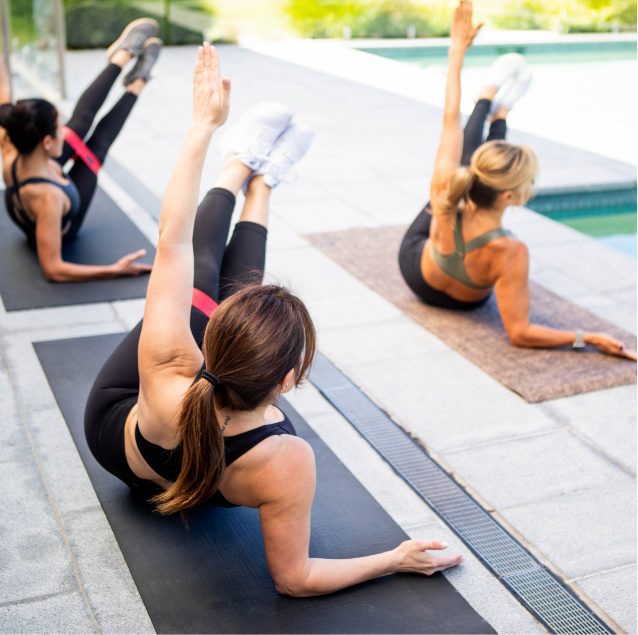Are you someone who prefers to pound the pavement to stay fit as you age? Well, strap up – our Xali physiotherapy expert is going to set you straight on the benefits of weight training pre- and post-menopause.
First, let me say there is nothing wrong with going for a walk or run. A leisurely walk with a friend to catch up on all the latest gossip is a wonderful way to feel connected and get the heart rate up. There is ample evidence to suggest that regular walks can be a protective factor for a range of long-term health conditions, especially when walking in nature. Walking as a health and well-being tool is excellent for our psychological health.
Running too has a great deal of research that espouses a myriad of benefits. Health, well-being and even mortality rates are all better off in the running population. Published in the British Journal of Sports Medicine, data showed that, those who ran at least once a week had 27% lower risk of all-cause mortality, 30% lower risk of cardiovascular-related death, and 23% lower risk of cancer mortality.
Hell, it has even been shown to reduce the risk of knee osteoarthritis (more on this in a different article!). However, if your first thought is to tie up those laces, then keep reading to see why incorporating weight training – especially during the hormonal changes during menopause – is something you will want to do.
Your body will thank you later.
HOW WEIGHT TRAINING WORKS
There’s an old adage of use it, or you lose it. There is also strain it to gain it. The premise is this: if you load tissues repetitively and appropriately, the body will respond appropriately. The body does this with a moderately high degree of specificity, in order to make that task easier.
Put simply, If you walk a lot, you typically get better at it. Similarly, if you lift weights regularly, your muscles, tendons, nerves, and joints adapt to help you be stronger to lift that weight more efficiently. Interestingly however, there is a body of evidence out there that strength training can make you a much better runner.
In general, strength training activities can positively affect muscle force through several different adaptations. Here’s the breakdown:
- Hypertrophy is the term to describe growth in muscle size and strength, cyclicly and progressively. That is, increased weight load over time.
- Hypertrophy is the outcome after muscles are exposed to repeated bouts of exercise causing micro damage to the muscle cells. When done properly, this is a good thing.
- Micro damage causes an inflammatory response and it is the pain you feel for the next 48hrs after a bout of exercise (also called delayed onset muscle soreness, or DOMS for short).
- It is also the stimulus for the body to mitigate future damage by repairing the damaged tissue and adding more muscle cells.
- Hypertrophy is aided by rest, dietary protein, certain hormones (e.g testosterone) and has a very strong genetic component as well.
SO, WHY SHOULD I WEIGHT TRAIN?
Now that we have the boring, but necessary sciencey bit out of the way, let’s get to it.
Working as a physiotherapist who typically helps rehabilitate a lot of perimenopausal women, there tends to be a perception that walking, whilst great as outlined earlier, will make women strong. I always have to burst their bubble with the following statement: People who run and walk won’t get strong. It is as simple as that.
As controversial as that statement may be to some, hopefully the above premise regarding the cyclical nature of progressive overload has given you an insight as to why you need strength training to make you strong. Often, the intensity of walking is insufficient to create an appreciable amount of muscle growth, and in turn strength.
It makes sense though, right? Look at the build of a marathon runner vs a weightlifter.
LOADING THROUGH MENOPAUSE
Menopause usually occurs in women between the ages of 47 and 55 years. There are both physical and psychological symptoms linked to menopause. The physical changes are driven by a loss of oestrogen hormones. One of these changes is increased belly fat, which is a risk for heart disease and Type 2 Diabetes. The other is the loss of muscle. Muscle loss means that women become weaker and stand more of a chance of developing problems such as osteoporosis.
Because osteoporosis risk skyrockets following menopause (oestrogen is needed to help lay down bone), strength training is especially vital. In fact, research shows osteoporosis is partially preventable with adequate amounts of calcium in the diet, along with progressive high-intensity resistance training. Strength training exercises will help to build bone and muscle strength, burn body fat, and rev up your metabolism.
IS IT TOO LATE TO START?
The great news is that the progress overload adaptation process never stops. So, if it’s been a while between lifts or if you think you are too old to lift weights, it is never too late! Progressive strength and weight training during menopause is efficient and effective to improve bone health, pack on muscle and retain function.
In fact, a recent study (the BELL Trial Protocol) prescribed heavy kettlebell style training for reasonably inactive men and women aged 59-79 years. Participants were able to train 5 days weekly for 3 months, consistently with no injuries. There were large improvements in grip strength, and significant changes in cardiovascular capacity, muscular strength and endurance, functional capacity, and body composition.
As shown in the BELL study (and numerous others), it all comes down to how you train. Training with higher loads generally provokes only marginally larger gains in muscle size. Lifting 85% of your individual maximum voluntary affects how quickly you can improve strength (rate of force development) compared to 60-80%. This is imperative for reducing frailty as we age.
RECOMMENDATIONS
In summary, muscle loss reduces your ability to function normally and can become a vicious cycle of decreasing activity and additional muscle loss. To break this cycle, we advise all women, but especially pre- and post-menopausal women – use strength conditioning routines that include increasingly heavier weights over time for the best results. And if you’re starting at zero, you can achieve improvement even with less frequent training.
However, if you’ve never set foot in a gym, it is certainly worth the investment into a good personal trainer, exercise physiologist, or sports physiotherapist. These professionals will certainly streamline the process and take out all the angst associated with starting something foreign.
Stephen Timms is the Principal Physiotherapist and Sport & Exercise Scientist at Praxis Physiotherapy in Brisbane, Australia. He is a published researcher in the physiotherapy and sports science field and has lectured at conferences around the world in various disciplines.
Stephen has played many sports himself at a competitive level, namely cricket, AFL, and tennis. His exposure to elite sport, personalised health, and clinical experience has equipped him with the skills to effectively treat musculoskeletal pathologies in all populations.
REFERENCES
RC. Blagrove, G Howatson, PR. Hayes. Effects of Strength Training on the Physiological Determinants of Middle- and Long-Distance Running Performance: A Systematic Review, Sports Med. 2018; 48(5):1117-1149
McLaughlin JE, Howley ET, Bassett DR Jr, et al. Test of the classic model for predicting endurance running performance. Med Sci Sports Exerc. 2010;42(5):991–7
Denadai BS, de Aguiar RA, de Lima LC, et al. Explosive training and heavy weight training are effective for improving running economy in endurance athletes: a systematic review and meta-analysis. Sports Med. 2017;47(3):545–54
Meigh, N. J., Keogh, J. W., Schram, B., Hing, W., & Rathbone, E. N. (2021). Effects of supervised high-intensity hardstyle kettlebell training on grip strength and health-related physical fitness in insufficiently active older adults: The BELL pragmatic controlled trial. medRxiv.
Mayer, F., Scharhag-Rosenberger, F., Carlsohn, A., Cassel, M., Müller, S., & Scharhag, J. (2011). The intensity and effects of strength training in the elderly. Deutsches Ärzteblatt International, 108(21), 359.













